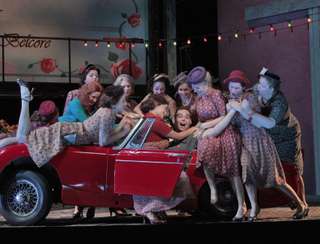|
Back
Pittas shines in charming L’Elisir Santa Fe
Santa Fe Opera House
07/04/2009 - & July 10, 15, August 6, 12*, 20, 25, 28
Gaetano Donizetti: L’Elisir d’amore
Dimitri Pittas (Nemorino), Jennifer Black (Adina), Thomas Hammons (Dr. Dulcamara), Patrick Carfizzi (Belcore), Rachel Schutz (Giannetta)
Santa Fe Opera Orchestra and Chorus, Susanne Sheston (chorus master), Corrado Rovaris (conductor)
Stephen Lawless (stage director), Ashley Martin-Davis (scenic/costume designer), Pat Collins (lighting designer)

D. Pittas (© Ken Howard)
With a lively young cast at the helm of Santa Fe Opera’s new production of Donizetti’s L’Elisir d’amore, the prospects of a hit were promising. The result was mostly successful, but as with any good L’Elisir , Nemorino stole the show.
From the first lines of "Quanto è bella", New York native Dimitri Pittas captivated the audience with a clear, well placed voice. The tenor sang Nemorino’s opening aria as well as any of his contemporaries can, displaying an endless legato line too often taken for granted with bel canto specialists today. During Pittas’ duets with Dulcamara, Adina and Belcore the tenor easily stood out with the most pure sound on the stage. Pittas’ only rival for the affection of the Santa Fe audience was his own acting. In this production, Nemorino’s other love is a classic convertible he houses in his garage. Pittas bounded in and out of it, polished it, drank in it, and used it in the end to nab Adina. Moving all over the stage and showing great chemistry with all cast members, Pittas commanded each scene from beginning to end. Even more impressive was the ease with which the young tenor showed his ability to act with his voice alone, as he brought out a plaintive side in "Adina credimi" and floated excellent pianissimi during "Chiedi all’aura". Surprisingly, Pittas’ only weak point came during "Una furtiva lagrima", where the tenor attacked the phrases with a bit too much force in what should be a subtle aria. Despite this, Pittas’ well-trained bel canto line combined with his easy, lyric top to set him apart from the rest of his colleagues on stage.
American Jennifer Black sang Pittas’ on stage love interest, Adina, and gave a reliable if not unique assumption. The soprano had problems with Donizetti’s coloratura during both "Della crudel Isotta" and her second duet with Dulcamara in act two. More importantly, Black had to split up what should be legato lines due to her lack of breath support. She sang a solid "Prendi" however, and acquitted herself well at the end of the night despite her need to work on bel canto style. Dramatically, Black made some interesting decisions. During "Chiedi allaura", she showed so much incredulity at her own words that it was absurd to think even Nemorino would believe her. The despair she showed before the wedding scene was so excessive that she seemed more like Lucia di Lammermoor than Adina. This inordinately pensive Adina clearly struggled with denying Nemorino from the very beginning; luckily, the playfulness lost in this portrayal didn’t hamper the action too much, though, and Black’s Adina did become more cheerful towards the end of the night.
The comedic king of the night was Patrick Carfizzi’s Belcore. With a swagger that brought laughs out of the entire house, the bass-baritone sang a perfectly egotistical "Come Paride vezzoso" and boasted a powerful sound during "Venti scudi" despite a bit of strain in his upper register. Bass Thomas Hammons, a veteran alumnus of Santa Fe Opera’s apprentice program, sang a solid Dulcamara. Hammons brought the expected charisma to "Udite, o rustici" and navigated the chatty sections of his duet with Nemorino with great aplomb. His Italian could use a little work, but he more than made up for it with his comedic timing. Lastly, the already thankless role of Giannetta became even more dreadful in this production, as soprano Rachel Schutz had to stand around during scenes where she wasn’t needed and even had a bucket of water thrown on her! Schutz possesses a small but pretty voice; credit goes to her for being a good sport in the small role and managing to stuff in some clever comedy during the "Dell’elisir mirabile" scene. Bel canto specialist Corrado Rovaris led the company’s conglomerate orchestra in a lively performance and deferred to the cast on stage at all the right times.
Ashley Martin-Davis’ colorful, 1940s-Italy sets proved reliable throughout the performance. The open design allowed for quick scene changes and easy interaction between the singers. A billboard stood high above the stage and changed periodically to set the mood for each scene. The non-vocal star of the night came in the form of the classic red convertible which the garage mechanic Nemorino restored over the course of the evening. Stage director Stephen Lawless played it mostly safe but made a few odd choices, notably some strange stage business before Dulcamara’s aria and the already mentioned depression of Jennifer Black’s Adina. To his credit, Lawless also added some clever touches and mostly let the story tell itself.
Santa Fe has served as a feeder to the major companies of the world for several decades; if Pittas’ success at other houses wasn’t enough to confirm his arrival as a leading lyric tenor, his Nemorino this summer will take care of that in short order. With a solid cast supporting Pittas, Santa Fe has a hit on its hands in this L’Elisir d’amore.
The Santa Fe Opera
Paul Wooley
|